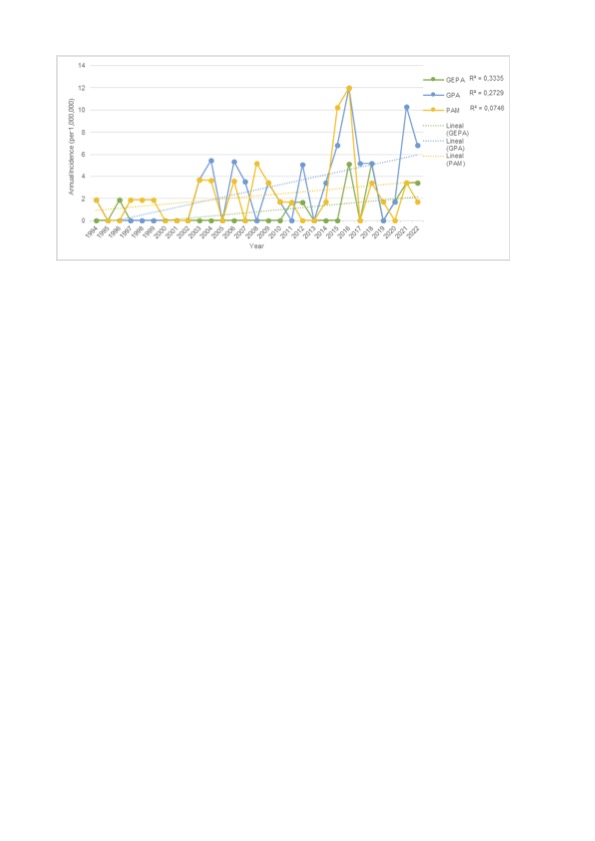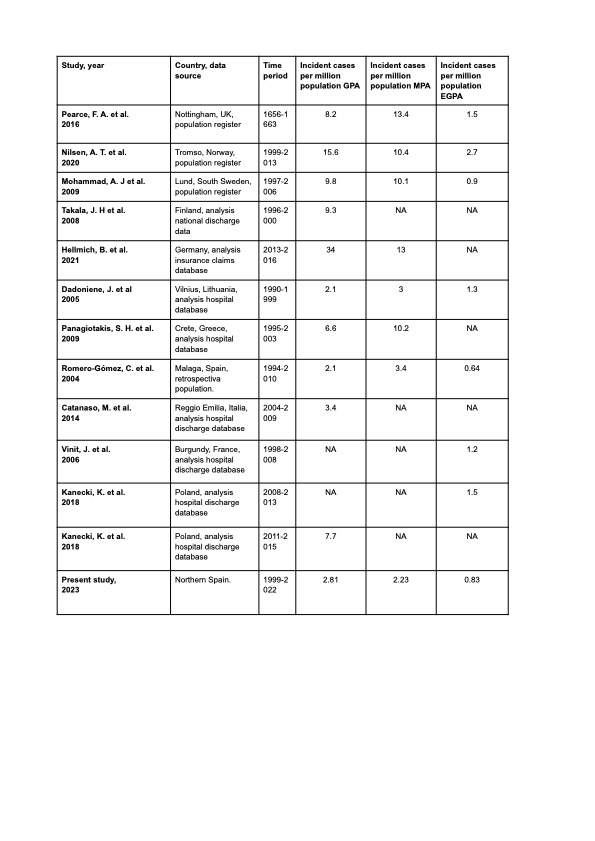Session Information
Date: Monday, November 13, 2023
Title: (1534–1553) Vasculitis – ANCA-Associated Poster II: Epidemiology, Outcomes, & Classification
Session Type: Poster Session B
Session Time: 9:00AM-11:00AM
Background/Purpose: Anti-neutrophil cytoplasmic antibodies (ANCA)-associated vasculitis (AAV) includes granulomatosis with polyangiitis (GPA), eosinophilic granulomatosis with polyangiitis (EGPA) or microscopic polyarteritis (MPA). Precise estimation of the incidence of AAV has been difficult due to the absence of reliable diagnostic criteria.
To estimate the incidence in a Northern Spanish population-based cohort.
Methods: Population-based study of 132 patients diagnosed with small vessel vasculitis between 1994 and 2022 in a tertiary hospital. Finally, 98 patients were included as AAV according to ACR/EULAR 2022 criteria (1). Incidence was estimated by gender, age, and year of diagnosis.
Results: AAV was diagnosed in 98 (49 women/ 49 men) patients: GPA (n=47, 48%) MPA (n=37,37.8%) and EGPA (n=14, 14.3%). Annual incidences were estimated in AAV (Figure). GPA annual incidence in our population area in the 1994-2022 period was 2.81 per 1,000,000 people, 95% CI: 3.77-1.85 (2.82 [4.35-1.29] in males and 2.80 [4.50-1.09] in females). An upward trend in annual incidence over time was observed with rates ranging from 1.88 in 1994 to 6.84 in 2022 (weak correlation; r 2=0.2729). On the other hand, MPA annual incidence was 2.23 per 1,000,000 people (1.92 [3.55-0.27] in males and 2.46 [4.07-0.85] in females). Rates ranged from 1.88 in 1994 to 1.71 in 2022 with an upward trend over time (very weak correlation; r 2=0.0746). In the case of GEPA, annual incidence was 0.83 per 1,000,000 people, 95% CI: 1.72-0.06 (1.22 [2.74-0.30] in males and 0.46 [2.29-1.37] in females). As in the other types of AAV, there was an upward trend over time with variations of from 1.88 in 1999 to 3.42 in 2022 (weak correlation; r 2=0.3335). A comparison between different geographical areas is summarized in Table. Wide variations in annual incidence per million were observed in all AAV (GPA 2.1-34; MPA 2.23-10.4; EGPA 0.64-2.7). The highest annual incidence of all AAV was observed in nordic countries and central Europe while the lowest in Southern Europe.
Conclusion: There seems to be a progressive increase in incidence of AAV over the years in the studied population. Annual incidence in our population was similar to that of other southern European countries.
To cite this abstract in AMA style:
Al Fazazi S, Benavides F, Herrero-Morant A, Calvo Río V, renuncio garcia m, escagedo Cagigas c, rodriguez Vidriales m, Blanco R. ANCA-associated Vasculitis Incidence in a Norther Spanish Health Region [abstract]. Arthritis Rheumatol. 2023; 75 (suppl 9). https://acrabstracts.org/abstract/anca-associated-vasculitis-incidence-in-a-norther-spanish-health-region/. Accessed .« Back to ACR Convergence 2023
ACR Meeting Abstracts - https://acrabstracts.org/abstract/anca-associated-vasculitis-incidence-in-a-norther-spanish-health-region/


